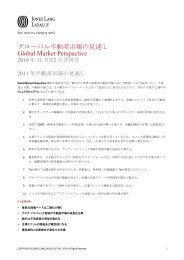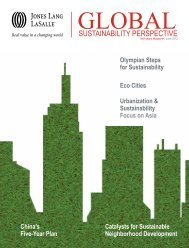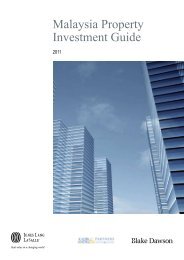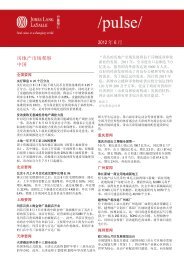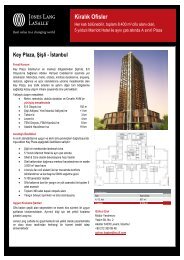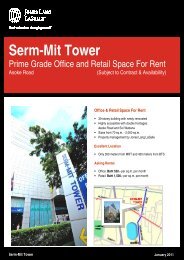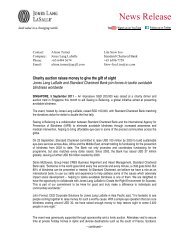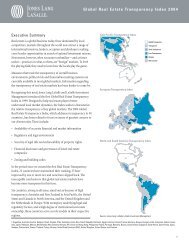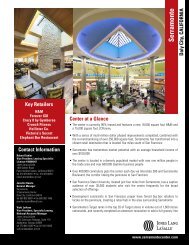Download current issue in PDF - Jones Lang LaSalle
Download current issue in PDF - Jones Lang LaSalle
Download current issue in PDF - Jones Lang LaSalle
You also want an ePaper? Increase the reach of your titles
YUMPU automatically turns print PDFs into web optimized ePapers that Google loves.
Global Susta<strong>in</strong>ability Perspective<br />
October 2012
2 Global Susta<strong>in</strong>ability Perspective October 2012<br />
Extract<strong>in</strong>g value from susta<strong>in</strong>ability<br />
S<strong>in</strong>ce the emergence of green build<strong>in</strong>gs a decade or more ago, our<br />
understand<strong>in</strong>g of susta<strong>in</strong>able construction and build<strong>in</strong>g management<br />
has evolved quite significantly. Green build<strong>in</strong>g certification systems<br />
such as LEED or BREEAM have systematically def<strong>in</strong>ed which<br />
susta<strong>in</strong>able features are most effective and, slowly, such build<strong>in</strong>g<br />
dist<strong>in</strong>ctions have helped to redef<strong>in</strong>e Grade A build<strong>in</strong>gs <strong>in</strong> some of<br />
the larger real estate <strong>in</strong>vestment markets. While green certifications<br />
have popped up across the globe <strong>in</strong> their thousands for new<br />
completions, the f<strong>in</strong>ancial challenge <strong>in</strong> ‗green<strong>in</strong>g‘ exist<strong>in</strong>g stock and<br />
<strong>in</strong> action<strong>in</strong>g even some of the more obvious energy efficiency<br />
<strong>in</strong>itiatives has meant slow progress. In this <strong>issue</strong> of the Global<br />
Susta<strong>in</strong>ability Perspective we look at some of the more <strong>in</strong>novative<br />
retrofit f<strong>in</strong>ance approaches and tools, and how they work <strong>in</strong> the<br />
United States. We will also provide some <strong>in</strong>sights <strong>in</strong>to how to make<br />
the bus<strong>in</strong>ess case and estimate return on <strong>in</strong>vestments for LEED<br />
certifications.<br />
As susta<strong>in</strong>ability is not only limited to <strong>in</strong>dividual build<strong>in</strong>gs, our guest<br />
contributor for this <strong>issue</strong> and co-founder of the World Future<br />
Council, Herbert Girardet, provides his view on how entire cities, <strong>in</strong><br />
challeng<strong>in</strong>g environments such as the Gulf States, are tackl<strong>in</strong>g their<br />
futures.<br />
In parallel with the rise of significant volumes of susta<strong>in</strong>able build<strong>in</strong>g<br />
<strong>in</strong>vestments, we have seen the <strong>in</strong>troduction of benchmark<strong>in</strong>g tools<br />
at enterprise levels. They are help<strong>in</strong>g to track the impact that<br />
susta<strong>in</strong>ability strategies are hav<strong>in</strong>g on property companies and to<br />
what extent they are follow<strong>in</strong>g their commitments <strong>in</strong> green<strong>in</strong>g their<br />
assets. Two recent susta<strong>in</strong>ability benchmark<strong>in</strong>g results publications,<br />
EPRA and GRESB, show you who the leaders are and who is still<br />
catch<strong>in</strong>g up.<br />
We hope that this <strong>issue</strong> aga<strong>in</strong> provides enrich<strong>in</strong>g perspectives on<br />
susta<strong>in</strong>able real estate across the globe and we thank you for your<br />
cont<strong>in</strong>ued readership and feedback.<br />
For further <strong>in</strong>formation please contact<br />
Franz Jenowe<strong>in</strong><br />
Director – Global Susta<strong>in</strong>ability Perspective
Build<strong>in</strong>g energy retrofit -<br />
owners need conv<strong>in</strong>c<strong>in</strong>g, not just f<strong>in</strong>anc<strong>in</strong>g<br />
The pace of energy-efficient upgrades by portfolio owners <strong>in</strong> the<br />
U.S. is slow<strong>in</strong>g. In a recent survey, 78% of build<strong>in</strong>g owners plan to<br />
perform upgrades over the next two years, compared to 91% who<br />
said they spent money on susta<strong>in</strong>ability improvements dur<strong>in</strong>g the<br />
past two years. It is a commonly-held belief <strong>in</strong> the U.S. that the<br />
recent decl<strong>in</strong>e <strong>in</strong> the number of susta<strong>in</strong>able retrofits to commercial<br />
build<strong>in</strong>gs by owner/<strong>in</strong>vestors is connected to a lack of available<br />
f<strong>in</strong>anc<strong>in</strong>g. While that may certa<strong>in</strong>ly be true <strong>in</strong> some <strong>in</strong>stances, the<br />
experience of <strong>Jones</strong> <strong>Lang</strong> <strong>LaSalle</strong>‘s teams serv<strong>in</strong>g office build<strong>in</strong>g<br />
owners suggests otherwise. In more <strong>in</strong>stances, these clients have<br />
told us that the biggest hurdle is not f<strong>in</strong>d<strong>in</strong>g capital, but prov<strong>in</strong>g that<br />
the expenditure is worth it on the bottom l<strong>in</strong>e.<br />
This discovery is backed by <strong>in</strong>dustry f<strong>in</strong>d<strong>in</strong>gs as well. In extensive<br />
research used to create its SmartMarket Reports, McGraw-Hill<br />
Construction reveals that <strong>in</strong> a survey of owners who had recently<br />
performed a susta<strong>in</strong>able capital improvement, 85% had self-<br />
f<strong>in</strong>anced it. Only 6% took out bank loans. The notion that a post-<br />
recessionary reduction of lend<strong>in</strong>g capital has held back susta<strong>in</strong>able<br />
retrofits is less of a factor than some might have believed.<br />
Altruism aside, <strong>in</strong>vestors often feel that they lack many of the<br />
<strong>in</strong>centives that motivate corporate or public sector owners and/or<br />
occupiers to make susta<strong>in</strong>able property upgrades. Corporate<br />
occupiers can recoup <strong>in</strong>vestments many times over <strong>in</strong> energy cost<br />
sav<strong>in</strong>gs, but landlords either transfer utility costs to the tenant or<br />
share them on a pro-rata basis, so that the benefit is dim<strong>in</strong>ished or<br />
non-existent. Investors also are less concerned about public image<br />
than brand-conscious corporations or public entities that answer to<br />
taxpayers and voters. Neither do they see it as a way to help<br />
motivate, attract and reta<strong>in</strong> key employees, as occupiers do.<br />
Mak<strong>in</strong>g the case<br />
Owners <strong>in</strong>vest <strong>in</strong> build<strong>in</strong>gs to make money, and are programmed to<br />
spend only what is necessary to maximise their return. A key <strong>issue</strong><br />
affect<strong>in</strong>g owners‘ will<strong>in</strong>gness to spend on susta<strong>in</strong>able upgrades is<br />
the so-called ‗split <strong>in</strong>centive‘ where much or all of the monetary<br />
sav<strong>in</strong>gs from energy reduction migrates to their tenants, not them.<br />
While this can‘t be denied, there are ways for owners to <strong>in</strong>crease<br />
their payback from a susta<strong>in</strong>able <strong>in</strong>vestment. One way is to <strong>in</strong>clude<br />
a clause <strong>in</strong>to leases stat<strong>in</strong>g that if an owner makes a susta<strong>in</strong>able<br />
Global Susta<strong>in</strong>ability Perspective October 2012 3<br />
<strong>in</strong>vestment, they are automatically entitled to recover a stated<br />
percentage of energy cost sav<strong>in</strong>gs through an <strong>in</strong>creased rent or<br />
other means. This is becom<strong>in</strong>g a more common practice.<br />
It is also important for owners to look at other ways a susta<strong>in</strong>able<br />
<strong>in</strong>vestment can generate payback. Like a new lobby or elevator<br />
bank, a capital improvement <strong>in</strong> susta<strong>in</strong>ability makes an office<br />
build<strong>in</strong>g more desirable to tenants. They know that they can save<br />
on operat<strong>in</strong>g expenses, that their employees typically feel better<br />
about work<strong>in</strong>g <strong>in</strong> green space and that, <strong>in</strong> the case of large<br />
corporations, environmental benefits can contribute to overall<br />
organizational, even global targets for susta<strong>in</strong>ability, such as carbon<br />
reduction. These benefits can justify collect<strong>in</strong>g higher rent, or can<br />
<strong>in</strong>crease competitive advantage and occupancy rates. And when<br />
the build<strong>in</strong>g is sold, susta<strong>in</strong>able <strong>in</strong>vestments can be recouped <strong>in</strong> an<br />
<strong>in</strong>creased sales price. In fact, a 2011 study by Eichholtz, Kok and<br />
Quigley <strong>in</strong>dicated the premium for LEED certified or ENERGY STAR<br />
label build<strong>in</strong>gs is about 13%.<br />
Owners/<strong>in</strong>vestors mak<strong>in</strong>g susta<strong>in</strong>able retrofits have reported that<br />
while they don‘t expect ‗w<strong>in</strong>dfall‘ profitability from go<strong>in</strong>g green, they<br />
do feel that it contributes to their bottom l<strong>in</strong>e beyond energy sav<strong>in</strong>gs.<br />
While almost all build<strong>in</strong>g owners expect to decrease operat<strong>in</strong>g costs<br />
thanks to their <strong>in</strong>vestments,<br />
• Four out of five also expect to attract more tenants;<br />
• Almost three-quarters expect <strong>in</strong>creased ROI, with an average<br />
<strong>in</strong>crease of 4%;<br />
• One-fifth believe they will receive higher rents, with an average<br />
rent <strong>in</strong>crease of 1%; and<br />
• 57% expect to see an <strong>in</strong>crease <strong>in</strong> build<strong>in</strong>g value at an average<br />
of 5%.<br />
This confidence is borne out <strong>in</strong> the market as well. Accord<strong>in</strong>g to the<br />
SmartMarket Report, rental rates for LEED-certified build<strong>in</strong>gs - the<br />
cream of the susta<strong>in</strong>able crop - are 13% higher than for non-LEED.<br />
Another study cited <strong>in</strong> the report revealed that 14% of tenant firms<br />
said they would pay more to rent space with green features, with the<br />
premium threshold for most fall<strong>in</strong>g <strong>in</strong> the 2-3% range. Consider<strong>in</strong>g<br />
that tenants are hard pressed <strong>in</strong> the <strong>current</strong> economic climate to
4 Global Susta<strong>in</strong>ability Perspective October 2012<br />
spend anyth<strong>in</strong>g they aren‘t compelled to, this will<strong>in</strong>gness to pay<br />
more for green space is even more significant.<br />
Research suggests that owners favor susta<strong>in</strong>ability upgrades that<br />
are ‗visible‘ to tenants, and improve occupant comfort. Light<strong>in</strong>g was<br />
the most popular upgrade, figur<strong>in</strong>g <strong>in</strong> 94% - almost all - of owners‘<br />
retrofit programs Improv<strong>in</strong>g both natural and artificial light<strong>in</strong>g of<br />
offices is not only popular among tenants, it is typically one of the<br />
lowest cost, highest value green improvements an owner can make.<br />
Next <strong>in</strong> l<strong>in</strong>e were other upgrades directly related to high sav<strong>in</strong>gs and<br />
tenant comfort: more efficient HVAC systems (85% of owners),<br />
zoned temperature controls (74%) and build<strong>in</strong>g automation<br />
controls (72%).<br />
Evaluat<strong>in</strong>g the actual need<br />
Even when the importance of the bus<strong>in</strong>ess case exceeds that of<br />
obta<strong>in</strong><strong>in</strong>g f<strong>in</strong>anc<strong>in</strong>g, owners still want maximum impact - and proof of<br />
the value - for every dollar they spend. Less than one-third of<br />
ownership/<strong>in</strong>vestment firms have staff dedicated to susta<strong>in</strong>ability<br />
<strong>issue</strong>s. However, most firms are demonstrat<strong>in</strong>g a general<br />
will<strong>in</strong>gness to pursue green retrofits if the cost is fairly reasonable<br />
and the f<strong>in</strong>ancial value can be quantified. This is creat<strong>in</strong>g an ‗open<br />
door‘ for susta<strong>in</strong>ability consultants to educate owners/<strong>in</strong>vestors<br />
about less obvious opportunities that can be as green f<strong>in</strong>ancially as<br />
they are for the environment.<br />
<strong>Jones</strong> <strong>Lang</strong> <strong>LaSalle</strong> advises its clients that before seek<strong>in</strong>g<br />
<strong>in</strong>vestment capital, it is prudent to consider how all the systems and<br />
components work together, as well as <strong>in</strong>dividually. By mak<strong>in</strong>g<br />
improvements holistically <strong>in</strong>stead of <strong>in</strong> isolation, an owner‘s need -<br />
and expense - may be less than they th<strong>in</strong>k. It is important to<br />
analyze how all susta<strong>in</strong>able build<strong>in</strong>g components affect each other.<br />
For example, part of a $20 million susta<strong>in</strong>ability upgrade that one of<br />
our teams managed for New York‘s iconic Empire State Build<strong>in</strong>g<br />
was the replacement of 6,500 79-year-old w<strong>in</strong>dows with triple-<br />
glazed panes. The w<strong>in</strong>dows improved build<strong>in</strong>g temperature<br />
retention so well that a planned upgrade to the HVAC system was<br />
scaled back to a cost level that more than covered the cost of the<br />
w<strong>in</strong>dows, result<strong>in</strong>g <strong>in</strong> a net sav<strong>in</strong>g.<br />
From build<strong>in</strong>g automation systems to more efficient fans to cool<strong>in</strong>g<br />
tower upgrades, <strong>in</strong>dividual susta<strong>in</strong>ability improvements can prompt<br />
correspond<strong>in</strong>g efficiencies <strong>in</strong> other components and systems.<br />
Before owners look at f<strong>in</strong>anc<strong>in</strong>g options, they should consider - with<br />
outside expert assistance if necessary —creat<strong>in</strong>g a formal energy<br />
model that evaluates all aspects of the build<strong>in</strong>g for <strong>current</strong><br />
performance and helps prioritize energy conservation measures.<br />
The outcome will help to develop an ‗energy improvement roadmap‘<br />
to achieve the greatest energy sav<strong>in</strong>gs at the desired level of<br />
spend<strong>in</strong>g.<br />
Another way to stretch the value of your <strong>in</strong>vestment is to<br />
aggressively pursue tax <strong>in</strong>centives, utility rebates and other ‗reward‘<br />
programs for susta<strong>in</strong>able <strong>in</strong>vestments. In the U.S., green tax<br />
<strong>in</strong>centives can offset the upfront costs by 30-50% or more. At the<br />
federal level, encouraged by the White House‘s aggressive energy<br />
and climate program, proposed legislation <strong>in</strong>cludes extend<strong>in</strong>g tax<br />
credits to owners and allow<strong>in</strong>g them to claim energy tax credits for<br />
susta<strong>in</strong>able development. Exist<strong>in</strong>g tax <strong>in</strong>centives <strong>in</strong>clude deductions
of $0.60-$1.80 per square foot for HVAC and light<strong>in</strong>g systems that<br />
meet def<strong>in</strong>ed standards.<br />
F<strong>in</strong>anc<strong>in</strong>g outside of the box<br />
Most owners/<strong>in</strong>vestors are well aware of conventional capital<br />
sources for f<strong>in</strong>anc<strong>in</strong>g commercial property. Those <strong>in</strong> the U.S. also<br />
may want to <strong>in</strong>vestigate non-traditional f<strong>in</strong>anc<strong>in</strong>g mechanisms<br />
<strong>in</strong>clud<strong>in</strong>g:<br />
Property Assessed Clean Energy (PACE):<br />
In PACE programs, municipal governments loan money to<br />
consumers and bus<strong>in</strong>esses/<strong>in</strong>vestors for energy retrofits, and the<br />
loans are repaid over an assigned term - typically 15-20 years -<br />
through assessments on their annual property tax bills.<br />
Unfortunately, PACE has created problems with orig<strong>in</strong>al lenders on<br />
properties because property taxes are superior to all other<br />
obligations, creat<strong>in</strong>g problematic subord<strong>in</strong>ation scenarios. PACE<br />
was dealt a major blow <strong>in</strong> 2010 when the Federal Hous<strong>in</strong>g F<strong>in</strong>ance<br />
Agency, a major impetus to the program, stopped residential PACE<br />
f<strong>in</strong>anc<strong>in</strong>g <strong>in</strong> most locations. Though PACE is available for<br />
commercial f<strong>in</strong>anc<strong>in</strong>g <strong>in</strong> roughly half of U.S. states, many mortgage<br />
holders have non-subord<strong>in</strong>ation clauses <strong>in</strong> their contracts. The<br />
<strong>in</strong>dustry is <strong>current</strong>ly try<strong>in</strong>g to develop answers to this <strong>issue</strong>, so that<br />
PACE could become a viable option for energy retrofit f<strong>in</strong>anc<strong>in</strong>g.<br />
Energy Service Company (ESCO) Loans:<br />
In an ESCO arrangement, an energy service company will pay for,<br />
implement and own a susta<strong>in</strong>ability improvement to an owned<br />
build<strong>in</strong>g, charg<strong>in</strong>g the owner an agreed-upon percentage of the<br />
sav<strong>in</strong>gs generated, which <strong>in</strong> theory will pay for the upgrade over<br />
time. Unfortunately some mortgage holders have balked at ESCOs<br />
as well, and <strong>in</strong>clude clauses prohibit<strong>in</strong>g any permanent <strong>in</strong>stallations<br />
of equipment or systems that they do not own. For this reason,<br />
ESCO is not an option for many owner/<strong>in</strong>vestors.<br />
Managed Energy Service Agreements (MESA):<br />
In a MESA arrangement, an energy service company <strong>in</strong>stalls a<br />
susta<strong>in</strong>ability improvement at its own expense and actually pays the<br />
utility bill. The landlord pays a monthly fee that typically represents<br />
some sav<strong>in</strong>gs over previous conditions for them, but also permits<br />
the energy service company to profit from the arrangement. S<strong>in</strong>ce it<br />
is represented on the balance sheet as a fee <strong>in</strong>stead of a capital<br />
<strong>in</strong>vestment, it is considered an operat<strong>in</strong>g expense which can,<br />
depend<strong>in</strong>g on the lease, be passed through to tenants. Though<br />
Global Susta<strong>in</strong>ability Perspective October 2012 5<br />
somewhat complicated, MESA may represent the best potential<br />
‗w<strong>in</strong>‘ f<strong>in</strong>anc<strong>in</strong>g mechanism accessible to the greatest number of<br />
owners.<br />
In summary, most owners/<strong>in</strong>vestors are open to green retrofits, but<br />
they have to see that there is a good bus<strong>in</strong>ess case - translated as<br />
profit generat<strong>in</strong>g - for do<strong>in</strong>g so. And the susta<strong>in</strong>ability community<br />
can help by:<br />
• Establish<strong>in</strong>g benchmarks based on peer experience that<br />
demonstrate what owners can expect to ga<strong>in</strong> f<strong>in</strong>ancially from not<br />
just energy sav<strong>in</strong>gs, but tenant attraction/retention, rate<br />
premiums, build<strong>in</strong>g resale value and other considerations<br />
directly related to ROI.<br />
• Increas<strong>in</strong>g the accessibility and value of tax concessions, utility<br />
rebates and other <strong>in</strong>centives aimed directly at owners/<strong>in</strong>vestors.<br />
• Mak<strong>in</strong>g available more uncomplicated non-traditional f<strong>in</strong>anc<strong>in</strong>g<br />
options that directly serve their needs and ability to participate.<br />
The bottom l<strong>in</strong>e for susta<strong>in</strong>ability <strong>in</strong>vest<strong>in</strong>g is the same as it is for<br />
any other spend<strong>in</strong>g: regardless of how you pay for it, it must meet<br />
the owner‘s <strong>in</strong>vestment objectives. No matter how green the<br />
<strong>in</strong>vestment might be, if the return on <strong>in</strong>vestment is too low or the<br />
payback period is too long, the f<strong>in</strong>anc<strong>in</strong>g options are irrelevant; the<br />
<strong>in</strong>vestment will not be made.
6 Global Susta<strong>in</strong>ability Perspective October 2012<br />
Susta<strong>in</strong>able build<strong>in</strong>gs: ROI and value<br />
Putt<strong>in</strong>g a value on susta<strong>in</strong>able build<strong>in</strong>gs<br />
The biggest question today <strong>in</strong> the world of susta<strong>in</strong>able build<strong>in</strong>gs<br />
revolves around the ‗value-add‘.<br />
As more owners commit to green build<strong>in</strong>gs, they are demand<strong>in</strong>g<br />
hard facts on what they are gett<strong>in</strong>g for their susta<strong>in</strong>able <strong>in</strong>vestment.<br />
And, not surpris<strong>in</strong>gly, the focus quickly moves to energy and energy<br />
retrofit projects, s<strong>in</strong>ce they represent the biggest cost and the<br />
biggest potential return.<br />
In this <strong>issue</strong> of Global Susta<strong>in</strong>ability Perspective, we focus on the<br />
myriad approaches to retrofit projects, <strong>in</strong>clud<strong>in</strong>g the <strong>issue</strong> of<br />
f<strong>in</strong>anc<strong>in</strong>g.<br />
It‘s not as simple as it appears, and it takes a discipl<strong>in</strong>ed approach<br />
that considers many factors that supersede the potential of any<br />
particular project.<br />
1.<br />
2.<br />
First, engage a professional energy eng<strong>in</strong>eer<strong>in</strong>g firm to<br />
conduct an ‗energy assessment‘ to determ<strong>in</strong>e how your<br />
build<strong>in</strong>g is perform<strong>in</strong>g today and where problems may or<br />
may not exist. It may be possible to solve a particular<br />
problem through a procedural change that costs noth<strong>in</strong>g or<br />
very little. There is still a lot of ‗low hang<strong>in</strong>g fruit‘ <strong>in</strong> most<br />
build<strong>in</strong>gs. The energy assessment also establishes a<br />
basel<strong>in</strong>e aga<strong>in</strong>st which progress can be measured. Very<br />
important.<br />
Second, benchmark energy performance, us<strong>in</strong>g one of the<br />
various accepted systems, such as ENERGY STAR <strong>in</strong> the<br />
United States, for measur<strong>in</strong>g energy efficiency and allow<strong>in</strong>g<br />
comparisons to similar build<strong>in</strong>gs. Our experience is that<br />
the focus this br<strong>in</strong>gs to a property operations team, alone,<br />
will reduce energy consumption 2-3% per year.<br />
3.<br />
4.<br />
Third, if multiple energy reduction projects are under<br />
review, consider commission<strong>in</strong>g an ‗energy model‘. This is<br />
an advanced method for review<strong>in</strong>g various projects, but<br />
provides an analysis of the synergistic aspects of multiple<br />
projects. Too often, this concept is overlooked, and<br />
separate projects, designed <strong>in</strong> isolation, are over-designed<br />
at extra cost.<br />
Fourth, look at <strong>in</strong>centives and rebates. Governmental<br />
agencies and utilities are offer<strong>in</strong>g significant awards for<br />
energy projects.<br />
Once the value of a project is proven, it‘s time to consider f<strong>in</strong>anc<strong>in</strong>g<br />
options. And, don‘t overlook <strong>in</strong>ternal sources for fund<strong>in</strong>g. In many<br />
of the companies we work with, if we can make the f<strong>in</strong>ancial case for<br />
an energy <strong>in</strong>vestment, fund<strong>in</strong>g is often available.<br />
Putt<strong>in</strong>g the puzzle together, rather than look<strong>in</strong>g at the <strong>in</strong>dividual<br />
projects and pieces, is the best way to maximize the return and<br />
optimize the value. And, value is what is driv<strong>in</strong>g susta<strong>in</strong>able<br />
build<strong>in</strong>gs today.
Global Susta<strong>in</strong>ability Perspective October 2012 7<br />
Susta<strong>in</strong>ability and the impact on value – a UK perspective<br />
The impact on value of susta<strong>in</strong>ability cont<strong>in</strong>ues to be a conundrum<br />
for property <strong>in</strong>vestors and valuers <strong>in</strong> the UK. At every po<strong>in</strong>t <strong>in</strong> time,<br />
the property market is subject to many dynamics which <strong>in</strong>fluence the<br />
evaluation of an asset‘s <strong>current</strong> value. At present, these factors are<br />
a shortage of supply of prime <strong>in</strong>vestments and strong demand <strong>in</strong> the<br />
City and West End of London, particularly from <strong>in</strong>ternational<br />
<strong>in</strong>vestors. This contrasts with a lack of demand for secondary<br />
properties from either occupiers, given the weak economy, or<br />
<strong>in</strong>vestors, given the lack of f<strong>in</strong>ance.<br />
Susta<strong>in</strong>ability <strong>in</strong> the <strong>current</strong> market situation is therefore, to a certa<strong>in</strong><br />
extent, lower down the agenda for <strong>in</strong>vestors. As a result there is little<br />
evidence of property purchasers pay<strong>in</strong>g a premium for more<br />
susta<strong>in</strong>able build<strong>in</strong>gs. However, <strong>in</strong>vestors need to be aware of the<br />
susta<strong>in</strong>ability risk that can lead to <strong>in</strong>creased obsolescence and<br />
decl<strong>in</strong><strong>in</strong>g returns <strong>in</strong> the future.<br />
<strong>Jones</strong> <strong>Lang</strong> <strong>LaSalle</strong> has undertaken analysis, on behalf of a number<br />
of <strong>in</strong>vestor clients, of the impact on returns caused by susta<strong>in</strong>ability<br />
risk through the use of a discounted cashflow model and Monte<br />
Carlo simulation analysis. The f<strong>in</strong>d<strong>in</strong>gs can demonstrate the<br />
susceptibility of properties to susta<strong>in</strong>ability risk through the impact<br />
on the service charge, rental voids, forecast rents and yields, and<br />
how these can <strong>in</strong>fluence the anticipated <strong>in</strong>ternal rates of return.<br />
‗Current Market Value‘ reflects the exist<strong>in</strong>g market dynamics, but<br />
go<strong>in</strong>g forward, given advances <strong>in</strong> build<strong>in</strong>g specifications and<br />
changes <strong>in</strong> occupier and <strong>in</strong>vestor demand, properties will be<br />
considered aga<strong>in</strong>st susta<strong>in</strong>ability criteria <strong>in</strong> order to mitigate the<br />
potential negative impact of this risk on returns.
8 Global Susta<strong>in</strong>ability Perspective October 2012<br />
What’s the ROI on LEED certified build<strong>in</strong>gs for owners and<br />
<strong>in</strong>vestors?<br />
Many property owners and <strong>in</strong>vestors might prefer a susta<strong>in</strong>able<br />
portfolio built to LEED standards but - particularly <strong>in</strong> a sluggish<br />
economy - are unsure whether the f<strong>in</strong>ancial benefits will justify the<br />
cost.<br />
What does it cost?<br />
In a recent analysis of multiple new build<strong>in</strong>gs around the world,<br />
<strong>in</strong>ternational construction company Davis <strong>Lang</strong>don found that the<br />
average LEED build<strong>in</strong>g cost just below 2% more than the average<br />
non-LEED build<strong>in</strong>g – <strong>in</strong> monetary terms, slightly over $20,000 per $1<br />
million of construction cost. In analys<strong>in</strong>g LEED costs, <strong>in</strong>dividual<br />
green products and features sometimes cost more than traditional<br />
alternatives, but the overall project does not have to be more<br />
expensive. A great deal depends on whether the development team<br />
views LEED as an ‗add-on‘ to the project or an <strong>in</strong>tr<strong>in</strong>sic element of<br />
the design and development process.<br />
In <strong>Jones</strong> <strong>Lang</strong> <strong>LaSalle</strong>‘s experience as project and construction<br />
managers, we‘ve observed that a collaborative process that results<br />
<strong>in</strong> a greener build<strong>in</strong>g also results <strong>in</strong> a better perform<strong>in</strong>g build<strong>in</strong>g<br />
overall, reduced construction costs and development time.<br />
The Design-Build Institute of America has studied the effectiveness<br />
of different ways of construct<strong>in</strong>g green build<strong>in</strong>gs. They found that<br />
<strong>in</strong>tegrated project delivery methods - <strong>in</strong>clud<strong>in</strong>g those that <strong>in</strong>volve a<br />
project or construction manager - are more successful overall than<br />
traditional design-bid-build methods at achiev<strong>in</strong>g or exceed<strong>in</strong>g<br />
anticipated LEED levels. An effective collaborative approach to<br />
green development can achieve LEED compliance while actually<br />
cost<strong>in</strong>g less than a similar non-LEED build<strong>in</strong>g us<strong>in</strong>g a less efficient<br />
method.<br />
Are there <strong>in</strong>centives to defray the cost?<br />
In the U.S., green tax <strong>in</strong>centives can also offset the upfront costs by<br />
30-50% or more. Exist<strong>in</strong>g tax <strong>in</strong>centives <strong>in</strong>clude deductions of<br />
$0.30-$1.80 per square foot for HVAC and light<strong>in</strong>g systems that<br />
meet def<strong>in</strong>ed standards.<br />
What are the energy sav<strong>in</strong>gs?<br />
For anyone who plans to lease a large space for a long time, one of<br />
the strongest cases for LEED build<strong>in</strong>g can be found <strong>in</strong> utility cost<br />
sav<strong>in</strong>gs. A study reported <strong>in</strong> the GreenBiz Group‘s 2011 Green<br />
Build<strong>in</strong>g Market and Impact Report found that the average energy<br />
sav<strong>in</strong>gs for LEED new construction projects built <strong>in</strong> 2009 - weighted<br />
accord<strong>in</strong>g to sav<strong>in</strong>gs by type of project and its share of certified floor<br />
area - has been over 32%. For a large office build<strong>in</strong>g, these energy<br />
sav<strong>in</strong>gs typically recoup the additional cost of a LEED-level<br />
construction with<strong>in</strong> a few years.<br />
In The Cost-Effectiveness of Commercial-Build<strong>in</strong>gs Commission<strong>in</strong>g<br />
study sponsored by the Assistant Secretary for Energy Efficiency<br />
and Renewable Energy (U.S. Department of Energy), researchers<br />
found that of 150 exist<strong>in</strong>g build<strong>in</strong>gs studied, the comb<strong>in</strong>ed build<strong>in</strong>g<br />
energy sav<strong>in</strong>gs from susta<strong>in</strong>able retrofits were 18% with a<br />
correspond<strong>in</strong>g payback for <strong>in</strong>cremental green build<strong>in</strong>g costs of just<br />
over eight months. After that, annual sav<strong>in</strong>gs rang<strong>in</strong>g from about<br />
$45,000 to as high as $1.8 million per build<strong>in</strong>g would appear directly<br />
on the bottom l<strong>in</strong>e.<br />
How does LEED certification impact rental rates and<br />
vacancies?<br />
A much greater ROI for owner and <strong>in</strong>vestors is likely to be from the<br />
rent premiums and vacancy reductions that LEED-certified build<strong>in</strong>gs<br />
are obta<strong>in</strong><strong>in</strong>g almost across the board. In five 2010-2011 studies<br />
cited <strong>in</strong> the 2011 Green Build<strong>in</strong>g Market and Impact Report, LEED<br />
build<strong>in</strong>gs were found to command between 5% to 17% higher<br />
average rents than non-LEED build<strong>in</strong>gs. In our own research<br />
analysis for the Philadelphia market, <strong>Jones</strong> <strong>Lang</strong> <strong>LaSalle</strong> created<br />
what we call a ‗Green Gauge‘ market <strong>in</strong>dicator that compares area<br />
submarkets and build<strong>in</strong>g types. We found that green build<strong>in</strong>gs -<br />
def<strong>in</strong>ed as those with LEED or ENERGY STAR certification - overall<br />
received almost a $4 per square foot rent premium.<br />
Three of the five studies <strong>in</strong> the report also measured improvement <strong>in</strong><br />
vacancy rates. The f<strong>in</strong>d<strong>in</strong>gs showed that vacancies <strong>in</strong> LEED<br />
compared to non-LEED build<strong>in</strong>gs range from no difference to 7%<br />
lower at certified properties. <strong>Jones</strong> <strong>Lang</strong> <strong>LaSalle</strong>‘s Green Gauge<br />
found an average vacancy drop of over 3%, as well as a much<br />
faster absorption <strong>in</strong>to the market.
Can a LEED <strong>in</strong>vestment be recouped when a build<strong>in</strong>g is<br />
sold?<br />
Available data suggests that the small <strong>in</strong>cremental addition to<br />
construction costs for LEED build<strong>in</strong>g is multiplied many times over<br />
when a certified build<strong>in</strong>g is sold. The five studies <strong>in</strong> the Green<br />
Build<strong>in</strong>g report reported sale price premiums of 8.5% to 25% - all<br />
well above the less than 2% average premium for green<br />
construction. Even <strong>in</strong> a down economy, one study found that ―the<br />
large <strong>in</strong>creases <strong>in</strong> the supply of green build<strong>in</strong>gs between 2007 and<br />
2009, and the recent downturns <strong>in</strong> property markets, have not<br />
significantly affected the returns to green build<strong>in</strong>gs relative to those<br />
of comparable high-quality <strong>in</strong>vestments‖.<br />
If anyth<strong>in</strong>g, as time goes on, new build<strong>in</strong>gs not designed to LEED<br />
standards risk not only lower market value, but also obsolescence,<br />
as an ever-greater number of properties are certified. Just as you<br />
wouldn‘t design a new build<strong>in</strong>g to an aesthetic standard of 30 years<br />
ago, owners and <strong>in</strong>vestors should also consider how not<br />
construct<strong>in</strong>g a build<strong>in</strong>g to LEED quality will <strong>in</strong>creas<strong>in</strong>gly ‗date‘ an<br />
asset <strong>in</strong> the future.<br />
Considered as a whole, a LEED-certified build<strong>in</strong>g—constructed with<br />
efficient, <strong>in</strong>tegrated collaboration among the stakeholders—should<br />
be as green for ROI to your budget as it is for the environment.<br />
Global Susta<strong>in</strong>ability Perspective October 2012 9
10 Global Susta<strong>in</strong>ability Perspective October 2012<br />
Shanghai office build<strong>in</strong>gs set energy performance standards<br />
Ch<strong>in</strong>a‘s extraord<strong>in</strong>ary economic growth has led to real estate<br />
development on an unprecedented scale. The way <strong>in</strong> which this<br />
development proceeds will have huge implications for Ch<strong>in</strong>a‘s<br />
environment, the health of the country‘s population, and the<br />
feasibility of susta<strong>in</strong>ed growth <strong>in</strong> the future. Design<strong>in</strong>g and<br />
construct<strong>in</strong>g more efficient green build<strong>in</strong>gs and lower<strong>in</strong>g resources<br />
consumption has huge implications for susta<strong>in</strong>able economic<br />
growth. As Ch<strong>in</strong>a‘s largest city, and its <strong>in</strong>ternational and f<strong>in</strong>ancial<br />
center, Shanghai will play a crucial role <strong>in</strong> the country‘s pursuit of<br />
improved and susta<strong>in</strong>able build<strong>in</strong>g practices.<br />
The green office market <strong>in</strong> Shanghai today has received much<br />
publicity. A number of high-profile build<strong>in</strong>gs have begun to advertise<br />
their susta<strong>in</strong>able designs and certifications. In order to exam<strong>in</strong>e the<br />
progression of this new market, and to understand how today‘s<br />
offices are be<strong>in</strong>g designed and operated, <strong>Jones</strong> <strong>Lang</strong> <strong>LaSalle</strong><br />
assembled <strong>in</strong>formation on the design characteristics and resources<br />
consumption levels of 19 Grade A office build<strong>in</strong>gs <strong>in</strong> downtown<br />
Shanghai which were will<strong>in</strong>g to share detailed data with our<br />
Research team. These 19 build<strong>in</strong>gs represent about one-third of the<br />
city‘s total Grade A office stock <strong>in</strong> the CBD, with a total of 1.25<br />
million square meters of space. They <strong>in</strong>clude not only the most<br />
recognizable and technologically advanced, but also some of the<br />
most energy <strong>in</strong>tensive and expensive-to-operate build<strong>in</strong>gs <strong>in</strong> the<br />
city.<br />
In order to quantify the performance of office build<strong>in</strong>gs, we collected<br />
electricity consumption data for each build<strong>in</strong>g over a one-year<br />
period, which was then normalized based on gross floor area (GFA),<br />
the build<strong>in</strong>g‘s occupancy level and hours of operation per week. This<br />
allowed us to compare build<strong>in</strong>g performance based on like-for-like<br />
comparisons. Our normalization and data analysis was made<br />
possible us<strong>in</strong>g <strong>Jones</strong> <strong>Lang</strong> <strong>LaSalle</strong>‘s Energy and Susta<strong>in</strong>ability<br />
Platform (ESP). The build<strong>in</strong>gs <strong>in</strong> our analysis spent on average,<br />
approximately RMB 250 (US$40) per sq m per year on electricity<br />
bills. This means that for a typical 60,000 sq m office build<strong>in</strong>g, a 10-<br />
15% reduction <strong>in</strong> energy consumption needs would translate <strong>in</strong>to<br />
sav<strong>in</strong>gs of RMB 1.5-2.3 million (US$240,000-270,000) per year.<br />
Our survey of 19 Grade A office build<strong>in</strong>gs showed that those offices<br />
with strong susta<strong>in</strong>able management practices - <strong>in</strong>clud<strong>in</strong>g regular<br />
energy monitor<strong>in</strong>g, environmental assessments, achiev<strong>in</strong>g a Green<br />
Build<strong>in</strong>g certification and sett<strong>in</strong>g targets for energy use - were able<br />
to significantly reduce overall energy consumption. Each build<strong>in</strong>g <strong>in</strong><br />
our survey was assigned a susta<strong>in</strong>able management score based<br />
on their adoption of the aforementioned management practices.<br />
Build<strong>in</strong>gs received a score of between 0 and 11. Build<strong>in</strong>gs that<br />
scored between 7 and 11 <strong>in</strong> this survey used an average of 32%<br />
less electricity than those which scored between 0 - 6.<br />
le management score<br />
Chart 1: Average annual energy consumption of Grade A<br />
offices, Shanghai 2009/2010 – by susta<strong>in</strong>able management<br />
score<br />
Energy Consumption* by Susta<strong>in</strong>able Management Score<br />
Score<br />
0 to 6<br />
7 to 11<br />
-32%<br />
0.0 0.5 1.0 1.5 2.0 2.5 3.0<br />
*Note: Annual energy consumption of base build<strong>in</strong>g <strong>in</strong> kWh/sq m, normalised by<br />
operat<strong>in</strong>g hours and occupancy rate<br />
In light of this data, the management practices of an office build<strong>in</strong>g<br />
translate directly <strong>in</strong>to lower energy consumption over a build<strong>in</strong>g‘s<br />
lifetime. S<strong>in</strong>ce studies have shown that between 80-85% of a<br />
build<strong>in</strong>g‘s environmental impact occurs dur<strong>in</strong>g the lifetime of the<br />
build<strong>in</strong>g, rather than dur<strong>in</strong>g the construction or demolition phases,<br />
improv<strong>in</strong>g day-to-day operations is the most effective method for<br />
reduc<strong>in</strong>g a build<strong>in</strong>g‘s impact on the environment. To this end, we<br />
believe that operational certifications, such as LEED for Exist<strong>in</strong>g<br />
Build<strong>in</strong>gs: Operations & Ma<strong>in</strong>tenance (EBOM), are the best method<br />
for ensur<strong>in</strong>g that a build<strong>in</strong>g both performs as its design <strong>in</strong>tends and<br />
can communicate this improved level of performance to potential<br />
tenants <strong>in</strong> the market. Operational performance has been<br />
<strong>in</strong>corporated <strong>in</strong> Ch<strong>in</strong>a‘s Three Star Green Build<strong>in</strong>g rat<strong>in</strong>g system and<br />
is a new factor <strong>in</strong> the LEED 2012 certification scheme, mean<strong>in</strong>g that
these organizations are beg<strong>in</strong>n<strong>in</strong>g to realize the crucial importance<br />
of on-go<strong>in</strong>g management and monitor<strong>in</strong>g for build<strong>in</strong>g performance.<br />
Based on our prelim<strong>in</strong>ary analysis of the <strong>current</strong> marketplace and<br />
our knowledge of future office developments, we believe that<br />
Shanghai will transform dramatically over the next few years and a<br />
rental performance gap between green and non-green build<strong>in</strong>gs will<br />
widen quickly. As this new market evolves, exist<strong>in</strong>g office build<strong>in</strong>gs<br />
will need to improve their performance if they want to rema<strong>in</strong><br />
competitive with the new standards set by higher-perform<strong>in</strong>g green<br />
build<strong>in</strong>g projects. We believe that one of the most important ways for<br />
them to achieve this will be to enhance their management practices<br />
so as to affect lower energy use and optimize day-to-day build<strong>in</strong>g<br />
performance.<br />
Chart 2: % Share of LEED Office completions vs non-LEED<br />
completions, 2012-2016 estimates, Shanghai CBD<br />
000 sqm<br />
1000<br />
800<br />
600<br />
400<br />
200<br />
0<br />
LEED*<br />
Non-LEED<br />
43%<br />
13%<br />
42%<br />
2012 2013 2014 2015 2016<br />
*Note: LEED certified, pre-certified or registered projects.<br />
48%<br />
33%<br />
Global Susta<strong>in</strong>ability Perspective October 2012 11
12 Global Susta<strong>in</strong>ability Perspective October 2012<br />
Is Gulf’s newly-created urban civilisation future-proof?<br />
Summary of an expert workshop held <strong>in</strong> Dubai, 20-24 September 2012<br />
Visit<strong>in</strong>g cities such as Dubai, Abu Dhabi, Doha, Manama, Jeddah or<br />
Kuwait City one could be forgiven for th<strong>in</strong>k<strong>in</strong>g one was halluc<strong>in</strong>at<strong>in</strong>g<br />
or experienc<strong>in</strong>g a desert mirage. How can these huge, gleam<strong>in</strong>g<br />
cities exist <strong>in</strong> a landscape devoid of water? And how long can they<br />
last?<br />
For time immemorial, water scarcity and severely limited food<br />
supplies have curtailed population growth <strong>in</strong> the Gulf. The few small<br />
urban settlements were concentrated on the coast. A few<br />
sheikhdoms controlled vast desert areas, <strong>in</strong>clud<strong>in</strong>g several oases.<br />
Everyth<strong>in</strong>g changed when oil was discovered <strong>in</strong> the 1930s. Today<br />
the Gulf nations produce about a quarter of the world's oil and gas.<br />
The vast revenues have been fossilised <strong>in</strong>to half a dozen new cities<br />
and one of them, Dubai, has become a global f<strong>in</strong>ancial and transit<br />
centre.<br />
But all is not well. The ever-ris<strong>in</strong>g expectations of the newly-<br />
urbanised local population are set aga<strong>in</strong>st the <strong>in</strong>evitable depletion of<br />
oil and gas supplies. But the structures that have been created – tall<br />
glass build<strong>in</strong>gs, stunn<strong>in</strong>g villas and hotels, and vast road systems –<br />
are ‗gas guzzlers‘ utterly dependent on a daily dose of cheap fossil<br />
fuels and desal<strong>in</strong>ated water.<br />
In contrast, the architecture and layout of the old coastal towns was<br />
very different. Houses and their cool<strong>in</strong>g towers were constructed to<br />
counter the hot summer w<strong>in</strong>ds. Gypsum facades reflected the sun‘s<br />
rays and thick external walls kept the cool <strong>in</strong> and the heat out.<br />
Narrow streets and lanes assured shad<strong>in</strong>g and lowered external<br />
temperatures.<br />
In today‘s Gulf cities these narrow pedestrian streets have given<br />
way to multi-lane urban motorways where the car is k<strong>in</strong>g. The new<br />
Gulf cities weren‘t built to be susta<strong>in</strong>able – they may be the world‘s<br />
least susta<strong>in</strong>able places. Accord<strong>in</strong>g to the World Bank, Qatar has<br />
the world‘s highest CO2 emissions, 49.1 metric tons per<br />
person/year. Kuwait with 30.1 tons is second highest, closely<br />
followed by the UAE with 25.5 and Bahra<strong>in</strong> with 21.3 tons, then<br />
Oman with 17.3 and Saudi Arabia with 16.6 tons. (The U.S. and<br />
Australia emit about 20 tons per person/year.)<br />
The ecological and economic externalities of Gulf cities, and their<br />
vulnerability to global f<strong>in</strong>ancial upheavals, need to be addressed. As<br />
oil and gas supplies peak, and as the climate becomes hotter,<br />
ma<strong>in</strong>stream<strong>in</strong>g high energy efficiency standards and implement<strong>in</strong>g<br />
cost-effective renewable energy technology is urgently called for.<br />
One project, Masdar eco-city <strong>in</strong> Abu Dhabi, is aim<strong>in</strong>g to show the<br />
way: Masdar is <strong>in</strong>tended to become the world's most susta<strong>in</strong>able<br />
new low-carbon city, powered by solar energy. Inspired by<br />
traditional Arab architecture and urban plann<strong>in</strong>g, Masdar features<br />
walkable streets; thick-walled build<strong>in</strong>gs with shaded w<strong>in</strong>dows;<br />
courtyards; and w<strong>in</strong>d towers. The narrow streets of the first section<br />
of Masdar are up to 15 degrees cooler than city streets <strong>in</strong> downtown<br />
Abu Dhabi. Masdar‘s concepts are now be<strong>in</strong>g copied <strong>in</strong> Abu Dhabi‘s<br />
Estidama policies – Estidama is the Arab word for susta<strong>in</strong>ability.<br />
More and more decision makers <strong>in</strong> the Gulf are realis<strong>in</strong>g the<br />
vulnerability of their new cities and the need for <strong>in</strong>tegrated plann<strong>in</strong>g.<br />
Energy supply and management, transport, hous<strong>in</strong>g development,<br />
commerce, food and water supply need to come together <strong>in</strong> a new<br />
<strong>in</strong>tegrated process if the Gulf‘s newly-created urban civilisation is to<br />
become future-proof.<br />
These are the solutions that were discussed <strong>in</strong> our workshop:<br />
• Well-<strong>in</strong>tegrated urban plann<strong>in</strong>g and management<br />
• Land-use plann<strong>in</strong>g <strong>in</strong> favour of compact urban form<br />
• Efficient use of water and reuse of waste water<br />
• Rout<strong>in</strong>e compost<strong>in</strong>g and reuse of organic waste<br />
• Recycl<strong>in</strong>g and remanufactur<strong>in</strong>g of all other waste<br />
• Maximum energy efficiency <strong>in</strong> build<strong>in</strong>gs<br />
• Renewable energy production and smart grids<br />
• Transition to efficient electric transport systems<br />
The awareness to <strong>in</strong>itiate such changes <strong>in</strong> the Gulf is grow<strong>in</strong>g fast.<br />
But actual implementation has hardly begun.<br />
Herbert Girardet<br />
International consultant on susta<strong>in</strong>able and regenerative plann<strong>in</strong>g<br />
and co-founder of the World Future Council
Global Susta<strong>in</strong>ability Summit Rio+20:<br />
Implications for real estate<br />
The UN Conference on Susta<strong>in</strong>able Development, ‗Rio+20‘, took<br />
place <strong>in</strong> June 2012 <strong>in</strong> Rio de Janeiro, mark<strong>in</strong>g the 20th anniversary<br />
of the 1992 Earth summit.<br />
The Conference focused on creat<strong>in</strong>g a green economy and an<br />
<strong>in</strong>stitutional framework for susta<strong>in</strong>able development, with three<br />
primary objectives:<br />
1. To secure renewed political commitment to susta<strong>in</strong>able<br />
development;<br />
2. To assess the progress and implementation gaps <strong>in</strong> meet<strong>in</strong>g<br />
already agreed commitments; and<br />
3. To address new and emerg<strong>in</strong>g challenges.<br />
With some time hav<strong>in</strong>g passed s<strong>in</strong>ce the June Summit – enough for<br />
careful deliberation - we analyse the impacts that these objectives<br />
could have on the property sector, and the role of the private sector<br />
at Rio+20 and beyond.<br />
Secur<strong>in</strong>g political commitment<br />
Governments readily committed to cont<strong>in</strong>ue implement<strong>in</strong>g the<br />
orig<strong>in</strong>al 1992 Rio Declaration pr<strong>in</strong>ciples. Some Governments also<br />
took ambitious new steps - the UK government, for example,<br />
committed to explor<strong>in</strong>g how natural assets, such as fresh air and<br />
clean rivers, can be quantified <strong>in</strong> national accounts (‗GDP+‘) and<br />
also announced the <strong>in</strong>troduction of mandatory carbon report<strong>in</strong>g for<br />
its listed companies by 2013.<br />
Global Susta<strong>in</strong>ability Perspective October 2012 13<br />
Governments also asked for commitment from the private sector,<br />
and with specific regards to the built environment, sought to promote<br />
an <strong>in</strong>tegrated, holistic approach to plann<strong>in</strong>g and build<strong>in</strong>g susta<strong>in</strong>able<br />
cities through:<br />
• Greener build<strong>in</strong>gs;<br />
• Reduced waste;<br />
• Increased climate resilience; and<br />
• Doubl<strong>in</strong>g the share of renewable energy <strong>in</strong> the global energy mix<br />
by 2030.<br />
Assess<strong>in</strong>g progress and implementation gaps<br />
The UN Environment Programme (UNEP) presented encourag<strong>in</strong>g<br />
data demonstrat<strong>in</strong>g that the move towards a green economy is<br />
happen<strong>in</strong>g on a scale and at a speed never seen before, with<br />
US$180-200 billion of <strong>in</strong>vestments <strong>in</strong> clean energy <strong>in</strong> 2010, driven<br />
pr<strong>in</strong>cipally by emerg<strong>in</strong>g economies.<br />
However, The Future We Want, the Rio+20 outcome document,<br />
acknowledged that, despite global efforts, ―susta<strong>in</strong>able development<br />
rema<strong>in</strong>ed a distant goal, as development ga<strong>in</strong>s have been adversely<br />
affected by food <strong>in</strong>security, climate change and biodiversity loss‖.<br />
Address<strong>in</strong>g new and emerg<strong>in</strong>g challenges<br />
Although earlier <strong>issue</strong>s such as volatile energy prices, climate<br />
change and biodiversity loss had <strong>in</strong>tensified over the past 20 years,<br />
the global f<strong>in</strong>ancial crisis was identified as the most significant new<br />
challenge.<br />
With regards to the built environment, market barriers, lack of<br />
awareness, technical capacity and upfront cost were all identified as<br />
significant obstacles to realis<strong>in</strong>g the potential of energy efficient<br />
build<strong>in</strong>gs.
14 Global Susta<strong>in</strong>ability Perspective October 2012<br />
Three trends for the private sector at Rio and beyond<br />
The private sector‘s presence was felt much more strongly at<br />
Rio+20 than the orig<strong>in</strong>al Earth Summit, with three trends show<strong>in</strong>g a<br />
shift <strong>in</strong> bus<strong>in</strong>esses‘ views of susta<strong>in</strong>able development:<br />
Natural capital valuations<br />
Private sector-led <strong>in</strong>itiatives to account for the value of natural<br />
resources were launched. One example is the University of<br />
Cambridge-led ‗Natural Capital Leadership Compact‘, signed by 15<br />
global companies, committ<strong>in</strong>g to properly value and ma<strong>in</strong>ta<strong>in</strong><strong>in</strong>g<br />
natural assets.<br />
A further <strong>in</strong>itiative, the ‗Natural Capital Declaration‘ was <strong>in</strong>troduced,<br />
whereby 39 banks, <strong>in</strong>surers and <strong>in</strong>vestors committed to develop<strong>in</strong>g<br />
a methodology to <strong>in</strong>tegrate natural capital considerations <strong>in</strong>to<br />
f<strong>in</strong>ancial products and services.<br />
Corporate Report<strong>in</strong>g and Transparency<br />
Although the f<strong>in</strong>al Rio+20 communiqué watered down a proposal for<br />
large companies to report on susta<strong>in</strong>ability, it still provided a push<br />
for voluntary global disclosure of private sector impacts.<br />
Public-Private Partnership Models<br />
Public-private partnership was a key theme, promis<strong>in</strong>g to solve<br />
specific susta<strong>in</strong>ability problems, <strong>in</strong>clud<strong>in</strong>g ways to elim<strong>in</strong>ate fossil<br />
fuel subsidies and to tackle energy access and water supply<br />
challenges.<br />
Problems solved?<br />
Anyone expect<strong>in</strong>g Rio+20 to solve all our environmental and<br />
developmental challenges would have been disappo<strong>in</strong>ted - global<br />
<strong>issue</strong>s are highly complex and resist easy answers. However, the<br />
Summit did see real progress <strong>in</strong> a few important areas.<br />
The property sector, <strong>in</strong> particular, is expected to make significant<br />
and last<strong>in</strong>g contributions to the susta<strong>in</strong>able development agenda,<br />
through the construction of efficient, environmentally and socially<br />
susta<strong>in</strong>able build<strong>in</strong>gs. As Ban Ki-moon, Secretary-General of the<br />
United Nations, said at Rio+20: “The road to susta<strong>in</strong>ability runs<br />
through the world‟s towns and cities. By build<strong>in</strong>g susta<strong>in</strong>able<br />
towns and cities, you will build global susta<strong>in</strong>ability.”
Legislation Update<br />
United K<strong>in</strong>gdom - mandatory carbon report<strong>in</strong>g for all<br />
quoted companies from 2013<br />
In July, the UK government took a bold step to <strong>in</strong>crease<br />
transparency and accountability for bus<strong>in</strong>ess greenhouse gas<br />
(GHG) emissions. DEFRA, the UK government‘s Environment<br />
Department, released draft regulations for consultation. It will require<br />
all quoted companies to disclose Scope 1 and Scope 2 emissions<br />
(roughly correspond<strong>in</strong>g to owned vehicle fleets‘ and on-site energy<br />
consumption and energy supplied from utilities) <strong>in</strong> their Directors‘<br />
reports. The obligations will start for years end<strong>in</strong>g after 6 April 2013.<br />
The universe of bus<strong>in</strong>esses required to report on emissions has<br />
been expanded from ‗London Stock Exchange listed‘ to ‗all quoted<br />
companies‘. Consultation is ongo<strong>in</strong>g and further revisions to the<br />
guidance are expected. Assets throughout Europe will be affected,<br />
as listed companies <strong>in</strong>corporated <strong>in</strong> the UK will be required to report<br />
on global emissions.<br />
The enlarged scope of organisations <strong>in</strong>cludes all companies that are<br />
UK <strong>in</strong>corporated and whose equity share capital is officially listed <strong>in</strong><br />
an European Economic Area (EEA) state or is admitted to deal<strong>in</strong>g<br />
on either the New York Stock Exchange or NASDAQ.<br />
The government will consider expand<strong>in</strong>g the regulations to cover all<br />
‗large‘ private companies <strong>in</strong> 2015.<br />
European Union - Energy Efficiency Directive<br />
A new EU Directive on Energy Efficiency was agreed on 15 June<br />
2012 and accepted by the Council on 4 October 2012. It aims to<br />
improve energy efficiency <strong>in</strong> its member states, an <strong>in</strong>tegral objective<br />
of which is to lead a transformation <strong>in</strong> the energy performance of<br />
exist<strong>in</strong>g build<strong>in</strong>gs, <strong>in</strong> the same way as the Energy Performance of<br />
Build<strong>in</strong>gs Directive (EPBD) of 2002 and its recast of 2010 is lead<strong>in</strong>g<br />
the transformation for new build<strong>in</strong>gs.<br />
The key element of the directive, Article 4, creates the potential to<br />
significantly scale up the market for energy sav<strong>in</strong>g build<strong>in</strong>g<br />
renovations for the long term. The provision stipulates that by 30<br />
April 2014, member countries must establish a long-term strategy<br />
(i.e. beyond 2020 and lead<strong>in</strong>g up to 2050) for mobilis<strong>in</strong>g <strong>in</strong>vestment<br />
<strong>in</strong> build<strong>in</strong>g renovations to improve energy performance of the<br />
exist<strong>in</strong>g build<strong>in</strong>g stock to:<br />
• Provide an overview of the stock based on statistical sampl<strong>in</strong>g;<br />
Global Susta<strong>in</strong>ability Perspective October 2012 15<br />
• Identify cost-effective approaches based on type and climate;<br />
• Introduce policies and measures to stimulate cost-effective deep<br />
renovations (energy consumption reduction by a significant<br />
percentage to reach ‗very high‘ energy performance);<br />
• Def<strong>in</strong>e a forward-look<strong>in</strong>g perspective to guide <strong>in</strong>vestment and<br />
<strong>in</strong>dustry; and<br />
• Produce an evidence-based estimate of expected sav<strong>in</strong>gs and<br />
wider benefits.<br />
The first version of the strategy must be updated every three years<br />
and submitted as part of National Energy Efficiency Action Plans.<br />
S<strong>in</strong>gapore - Green Mark Certifications targets and<br />
subsidies for retrofits<br />
The S<strong>in</strong>gapore government has <strong>in</strong>creased its subsidies for the<br />
retrofitt<strong>in</strong>g of build<strong>in</strong>gs that will be ‗Green Mark‘ compliant. Start<strong>in</strong>g<br />
on 26 July 2012, the government <strong>in</strong>creased the subsidy from 35% to<br />
50% of total capex cost for build<strong>in</strong>g retrofits, depend<strong>in</strong>g on the level<br />
of certification achieved. The government will also co-fund those<br />
projects, <strong>in</strong>clud<strong>in</strong>g consult<strong>in</strong>g costs and hard construction costs.<br />
With this new subsidy program, as well as further new regulations -<br />
such as requirements for build<strong>in</strong>gs to have three annual audits and<br />
for utility companies to submit data on build<strong>in</strong>g energy consumption<br />
- S<strong>in</strong>gapore is quickly position<strong>in</strong>g itself as a global trailblazer <strong>in</strong><br />
green build<strong>in</strong>g policies.<br />
S<strong>in</strong>gapore‘s long-term target is for 80% of its total build<strong>in</strong>g stock to<br />
be Green Mark certified by 2030 – one of the most ambitious green<br />
build<strong>in</strong>g targets <strong>in</strong> the world. The target is be<strong>in</strong>g facilitated by a<br />
history and variety of government regulations, <strong>in</strong>centives and<br />
<strong>in</strong>itiatives, which have helped to establish S<strong>in</strong>gapore as a leader <strong>in</strong><br />
green build<strong>in</strong>g thought-leadership.<br />
Germany – sharply lower Solar PV Feed-<strong>in</strong> tariffs<br />
In Germany, as <strong>in</strong> many other countries, the Feed-<strong>in</strong> tariff scheme<br />
for solar energy generation and its subsidies has been lowered<br />
aga<strong>in</strong>. The most recent regulation concern<strong>in</strong>g Photovoltaic<br />
electricity generation (‗EEG 2012 PV-Novelle‘, applicable<br />
retroactively to 1 April 2012) saw a decrease of some 25% for Feed-<br />
<strong>in</strong> tariffs for roof <strong>in</strong>stallations between January and April of this year.<br />
Another 5-10% of subsidy reduction is planned by the end of<br />
the year.
16 Global Susta<strong>in</strong>ability Perspective October 2012<br />
In addition, subsidies will no longer be available for <strong>in</strong>stallations<br />
above 10MW and, for solar panels above 40KW, the Feed-<strong>in</strong> tariff<br />
only applies to 90% of electricity generation.<br />
Operational energy performance of build<strong>in</strong>gs and what is<br />
needed <strong>in</strong> UK government policy<br />
Today, Energy Performance Certificates (EPCs) are a mandatory<br />
requirement for the sale and lett<strong>in</strong>g of commercial build<strong>in</strong>gs <strong>in</strong> the<br />
UK. The UK government is <strong>in</strong> the process of consider<strong>in</strong>g further<br />
legislation aimed at reduc<strong>in</strong>g CO2 emissions from the commercial<br />
property sector. EPCs have played an important role generat<strong>in</strong>g<br />
awareness about energy consumption <strong>in</strong> build<strong>in</strong>gs and are a<br />
compliance <strong>issue</strong>. They can undoubtedly help to set goals for<br />
improved design and refurbishments of build<strong>in</strong>gs.<br />
However, EPCs are based on theoretical not actual energy<br />
performance and it is only through reductions <strong>in</strong> actual energy use<br />
that we will be able to meet energy and carbon reduction targets.<br />
Therefore, <strong>in</strong> the absence of a measure of actual energy<br />
consumption - for example, through Display Energy Certificates<br />
(DECs) - how can the commercial property sector fully understand<br />
the environmental impact of its build<strong>in</strong>gs, and communicate actual<br />
energy performance to the marketplace?<br />
This is the <strong>issue</strong> be<strong>in</strong>g tackled <strong>in</strong> the forthcom<strong>in</strong>g research by <strong>Jones</strong><br />
<strong>Lang</strong> <strong>LaSalle</strong> and the Better Build<strong>in</strong>gs Partnership, a coalition of<br />
London‘s lead<strong>in</strong>g commercial property owners supported by the<br />
Mayor of London and the Greater London Authority. We analysed<br />
the actual energy use of over 200 office build<strong>in</strong>gs <strong>in</strong> London and<br />
compared performance with their EPC rat<strong>in</strong>gs. Our f<strong>in</strong>d<strong>in</strong>gs<br />
demonstrate the <strong>issue</strong> of correlation between EPC rat<strong>in</strong>gs bands<br />
and actual performance. The report is due to be launched <strong>in</strong> mid-<br />
November.
Global Susta<strong>in</strong>ability Perspective October 2012 17<br />
New EPRA/<strong>Jones</strong> <strong>Lang</strong> <strong>LaSalle</strong> survey uncovers the lead<strong>in</strong>g<br />
susta<strong>in</strong>ability reporters <strong>in</strong> Europe<br />
Seven companies w<strong>in</strong> „Gold‟ <strong>in</strong> <strong>in</strong>augural Susta<strong>in</strong>ability<br />
Awards<br />
Seven European listed property firms received the highest ‗Gold‘<br />
position <strong>in</strong> the first EPRA Susta<strong>in</strong>ability BPR Awards. The jo<strong>in</strong>t<br />
EPRA and <strong>Jones</strong> <strong>Lang</strong> <strong>LaSalle</strong> report announced the results at the<br />
<strong>in</strong>dustry body‘s Annual Conference <strong>in</strong> Berl<strong>in</strong> <strong>in</strong> early September<br />
2012.<br />
EPRA‘s Susta<strong>in</strong>ability Best Practices Recommendations (sBPR)<br />
and correspond<strong>in</strong>g guidance were released <strong>in</strong> 2011 to help property<br />
companies produce comparable and best-<strong>in</strong>-class annual<br />
susta<strong>in</strong>ability reports. This year a new award scheme has been<br />
<strong>in</strong>troduced to raise awareness of the guidel<strong>in</strong>es published <strong>in</strong> 2011<br />
and to give recognition to companies who have started to adopt<br />
them.<br />
Philip Charls, Chief Executive of EPRA said: ―Congratulations to all<br />
the award w<strong>in</strong>ners. We hope their example will <strong>in</strong>spire many others<br />
to review their susta<strong>in</strong>ability report<strong>in</strong>g for compliance with EPRA's<br />
guidel<strong>in</strong>es. With 66% of the Index by market capitalisation already<br />
adopt<strong>in</strong>g these guidel<strong>in</strong>es, it is clear that the listed property sector is<br />
lead<strong>in</strong>g a step-change <strong>in</strong> the quality of susta<strong>in</strong>ability report<strong>in</strong>g‖.<br />
Eighty-four companies were reviewed by <strong>Jones</strong> <strong>Lang</strong> <strong>LaSalle</strong> to<br />
check compliance with the EPRA Susta<strong>in</strong>ability BPR. Those<br />
companies judged to have the best compliance with this standard<br />
have been given gold, silver and bronze awards. Fifteen awards<br />
were made <strong>in</strong> total, <strong>in</strong>clud<strong>in</strong>g seven gold awards to British Land,<br />
Citycon, Cof<strong>in</strong>immo, Hammerson, Klépierre, Unibail-Rodamco and<br />
Shaftesbury. A further four companies received silver, while four<br />
others collect<strong>in</strong>g bronze awards.<br />
Gareth Lewis, EPRA‘s Director of F<strong>in</strong>ance said: ―Our thanks to APG<br />
for sponsor<strong>in</strong>g these awards, which are key to rais<strong>in</strong>g awareness of<br />
these important guidel<strong>in</strong>es. We anticipate that over a short period of<br />
time, the EPRA Susta<strong>in</strong>ability BPR will become the established<br />
report<strong>in</strong>g standard for property firms and <strong>in</strong>vestors, <strong>in</strong> the same way<br />
that EPRA‘s f<strong>in</strong>ancial report<strong>in</strong>g BPRs are used today.‖<br />
Here are some of the highlights from the report:<br />
• UK companies dom<strong>in</strong>ate the European survey, so it is<br />
unsurpris<strong>in</strong>g that UK corporates cont<strong>in</strong>ue to set the standard,<br />
with seven out of a total of fifteen awards be<strong>in</strong>g given to UK<br />
companies – three gold, three silver and one bronze.<br />
• With the average score of the 84 reviewed companies be<strong>in</strong>g<br />
only 22%, it is clear that listed companies need to ramp up<br />
efforts to further enhance the transparency of the sector.<br />
• The vast majority (79%) of companies that disclosed some<br />
susta<strong>in</strong>ability <strong>in</strong>formation claimed to have derived f<strong>in</strong>ancial<br />
value from susta<strong>in</strong>ability <strong>in</strong>itiatives.<br />
• There are early signs that lead<strong>in</strong>g firms will fully <strong>in</strong>tegrate<br />
susta<strong>in</strong>ability <strong>in</strong>formation <strong>in</strong>to their Annual F<strong>in</strong>ancial Reports<br />
rather than publish<strong>in</strong>g a separate Susta<strong>in</strong>ability Report <strong>in</strong><br />
future.<br />
The review was performed by susta<strong>in</strong>ability report<strong>in</strong>g specialists<br />
with<strong>in</strong> <strong>Jones</strong> <strong>Lang</strong> <strong>LaSalle</strong>‘s Susta<strong>in</strong>ability team between June and<br />
August 2012. This team has unrivalled knowledge of EPRA‘s sBPR<br />
and were <strong>in</strong>strumental <strong>in</strong> help<strong>in</strong>g EPRA develop the guidel<strong>in</strong>es <strong>in</strong><br />
consultation with its members <strong>in</strong> 2010/2011 and ensur<strong>in</strong>g<br />
consistency with other <strong>in</strong>itiatives.<br />
Global Real Estate Susta<strong>in</strong>ability Benchmark (GRESB) -<br />
European results<br />
Over 35 major <strong>in</strong>stitutional <strong>in</strong>vestors are us<strong>in</strong>g the Global Real<br />
Estate Susta<strong>in</strong>ability Benchmark (GRESB) worldwide to scrut<strong>in</strong>ise<br />
the susta<strong>in</strong>ability credentials of their <strong>in</strong>vestments and <strong>in</strong>vestment<br />
managers. The benchmark summarises <strong>in</strong>formation from 450<br />
property companies and funds worldwide, mak<strong>in</strong>g this the largest<br />
global susta<strong>in</strong>ability <strong>in</strong>itiative with 36,000 properties covered.<br />
Over 250 European property companies and funds participated <strong>in</strong><br />
this year‘s GRESB, represent<strong>in</strong>g 65% of the European market by<br />
value.
18 Global Susta<strong>in</strong>ability Perspective October 2012<br />
The Benchmark has been developed from an annual onl<strong>in</strong>e survey<br />
of 35 questions relat<strong>in</strong>g to company policy, practices and data on<br />
environmental impact (e.g. carbon emissions, waste output, energy<br />
use, etc.). Companies who complete the survey receive an<br />
<strong>in</strong>dividual score which is scrut<strong>in</strong>ised by the <strong>in</strong>vestment community.<br />
GRESB l<strong>in</strong>ks to the Global Report<strong>in</strong>g Initiative (GRI CRESS),<br />
EPRA‘s Best Practices Recommendations on Susta<strong>in</strong>ability<br />
Report<strong>in</strong>g (see our article on the 2012 EPRA Awards [INSERT<br />
LINK]) and the INREV Susta<strong>in</strong>ability Report<strong>in</strong>g Recommendations.<br />
On the positive side, the results show:<br />
• 88% have dedicated resources for implement<strong>in</strong>g susta<strong>in</strong>ability<br />
strategy;<br />
• At 81%, energy consumption is the ma<strong>in</strong> policy focus;<br />
• 60% of respondents collect and report data on energy<br />
consumption; and<br />
• 72% of the respondents used nationally-recognised certifications<br />
(of which 62% LEED and 28% BREEAM).<br />
However:<br />
• Only 8% of respondents have <strong>in</strong>formation on tenant-obta<strong>in</strong>ed<br />
energy use;<br />
• 40% of participants are still considered ‗Green Starters‘,<br />
disclos<strong>in</strong>g limited susta<strong>in</strong>ability <strong>in</strong>formation to the <strong>in</strong>vestment<br />
community – suggest<strong>in</strong>g that there is still significant room for<br />
improvement across the <strong>in</strong>dustry; and<br />
• The vast majority of participants are still heavily engaged <strong>in</strong><br />
policy formulation, but lack implementation and measurement.<br />
For additional <strong>in</strong>formation visit: www.GRESB.com
Global Susta<strong>in</strong>ability Perspective October 2012 19<br />
<strong>Jones</strong> <strong>Lang</strong> <strong>LaSalle</strong>’s 2011 CSR Report: A commitment to<br />
create susta<strong>in</strong>able value for clients, employees and<br />
communities<br />
Our 2011 Corporate Social Responsibility (CSR) Report documents<br />
our achievements and challenges, cover<strong>in</strong>g the most material CSR<br />
<strong>issue</strong>s to our bus<strong>in</strong>ess. The Report demonstrates how we are<br />
mak<strong>in</strong>g a difference for our clients, connect<strong>in</strong>g our employees<br />
around the globe and br<strong>in</strong>g<strong>in</strong>g value to our shareholders.<br />
The 2011 Report is focused around five strategic CSR <strong>issue</strong>s:<br />
1. Energy and climate<br />
2. Client service excellence<br />
3. Green build<strong>in</strong>gs<br />
4. Community commitment<br />
5. Workplace, wellbe<strong>in</strong>g and diversity<br />
Col<strong>in</strong> Dyer, President and CEO, states <strong>in</strong> his open<strong>in</strong>g message: ―We<br />
are help<strong>in</strong>g our clients and ourselves realize the value of corporate<br />
responsibility. Whether that <strong>in</strong>volves provid<strong>in</strong>g susta<strong>in</strong>ability-related<br />
advice to clients through many of our services, or leverag<strong>in</strong>g<br />
connections with<strong>in</strong> our own Firm to <strong>in</strong>tegrate our <strong>in</strong>ternal CSR<br />
efforts, susta<strong>in</strong>ability is not just aligned, but <strong>in</strong>creas<strong>in</strong>gly embedded,<br />
<strong>in</strong> everyth<strong>in</strong>g we do.‖<br />
Highlights from the past year <strong>in</strong>clude:<br />
• Documented $105 million <strong>in</strong> energy sav<strong>in</strong>gs and reduced<br />
587,000 metric tons of CO2e <strong>in</strong> the Firm‘s U.S. managed<br />
portfolio, the equivalent to remov<strong>in</strong>g over 115,000 passenger<br />
vehicles annually from the road;<br />
• Achieved the world‘s highest LEED® Plat<strong>in</strong>um score for a<br />
Commercial Interiors project <strong>in</strong> our Hong Kong corporate<br />
office;<br />
• Helped clients avert an estimated 1.22 million metric tons of<br />
CO2e per year s<strong>in</strong>ce 2007, result<strong>in</strong>g from <strong>in</strong>stalled or<br />
operational renewables;<br />
• Partnered with the Carbon Disclosure Project (CDP) to<br />
enhance and promote its ‗CDP Cities‘ climate change report<strong>in</strong>g<br />
program, which has grown to encompass 73 cities<br />
worldwide;<br />
• Ma<strong>in</strong>ta<strong>in</strong>ed corporate and employee charitable programs that<br />
raised more than $4.3 million and contributed 2,200<br />
volunteer<strong>in</strong>g days at local community projects;<br />
• <strong>LaSalle</strong> Investment Management, the <strong>in</strong>vestment advisory arm<br />
of <strong>Jones</strong> <strong>Lang</strong> <strong>LaSalle</strong>, committed to double the number of its<br />
properties that contribute data to Greenpr<strong>in</strong>t Foundation, a<br />
worldwide alliance of real estate <strong>in</strong>dustry stakeholders<br />
committed to reduc<strong>in</strong>g carbon emissions across the global<br />
property <strong>in</strong>dustry; and<br />
• Increased year-on-year employee participation <strong>in</strong> voluntary<br />
susta<strong>in</strong>ability tra<strong>in</strong><strong>in</strong>g by 119%, while also achiev<strong>in</strong>g 1,075<br />
accredited energy and susta<strong>in</strong>ability professionals by the end<br />
of 2011.<br />
<strong>Jones</strong> <strong>Lang</strong> <strong>LaSalle</strong>‘s 2011 CSR Report is based on Global<br />
Report<strong>in</strong>g Initiative (GRI) standards to a self-declared Level C.<br />
Additional <strong>in</strong>formation is available from <strong>Jones</strong> <strong>Lang</strong> <strong>LaSalle</strong>‘s CSR<br />
website and from a video where our Global Chief Operat<strong>in</strong>g and<br />
F<strong>in</strong>ancial Officer, Lauralee Mart<strong>in</strong>, discusses our CSR commitment.
20 Global Susta<strong>in</strong>ability Perspective October 2012<br />
Global Energy and Susta<strong>in</strong>ability Services Contacts:<br />
Dan Probst<br />
Chairman, Energy &<br />
Susta<strong>in</strong>ability Services<br />
+61 2 9220 8735<br />
dan.probst@am.jll.com<br />
Julie Hirigoyen<br />
EMEA Head of<br />
Susta<strong>in</strong>ability Services<br />
+44 (0)20 7399 5330<br />
julie.hirigoyen@eu.jll.com<br />
Peter Hilderson<br />
Asia Pacific Head of Energy<br />
& Susta<strong>in</strong>ability Services<br />
+61 2 9220 8735<br />
peter.hilderson@ap.jll.com<br />
Bob Best<br />
Americas Head of Energy<br />
& Susta<strong>in</strong>ability Services<br />
+1 312 228 2047<br />
bob.best@am.jll.com<br />
Franz Jenowe<strong>in</strong><br />
Global Susta<strong>in</strong>ability<br />
Perspective<br />
+44 (0)20 3147 1752<br />
franz.jenowe<strong>in</strong>@eu.jll.com<br />
COPYRIGHT © <strong>Jones</strong> <strong>Lang</strong> <strong>LaSalle</strong> IP, INC. 2012<br />
This publication is the sole property of <strong>Jones</strong> <strong>Lang</strong> <strong>LaSalle</strong> IP, Inc. and must not be copied, reproduced or transmitted <strong>in</strong> any form or by any means, either <strong>in</strong> whole or <strong>in</strong> part, without the prior written<br />
consent of <strong>Jones</strong> <strong>Lang</strong> <strong>LaSalle</strong> IP, Inc. The <strong>in</strong>formation conta<strong>in</strong>ed <strong>in</strong> this publication has been obta<strong>in</strong>ed from sources generally regarded to be reliable. However, no representation is made, or warranty<br />
given, <strong>in</strong> respect of the accuracy of this <strong>in</strong>formation. We would like to be <strong>in</strong>formed of any <strong>in</strong>accuracies so that we may correct them. <strong>Jones</strong> <strong>Lang</strong> <strong>LaSalle</strong> does not accept any liability <strong>in</strong> negligence or<br />
otherwise for any loss or damage suffered by any party result<strong>in</strong>g from reliance on this publication.



